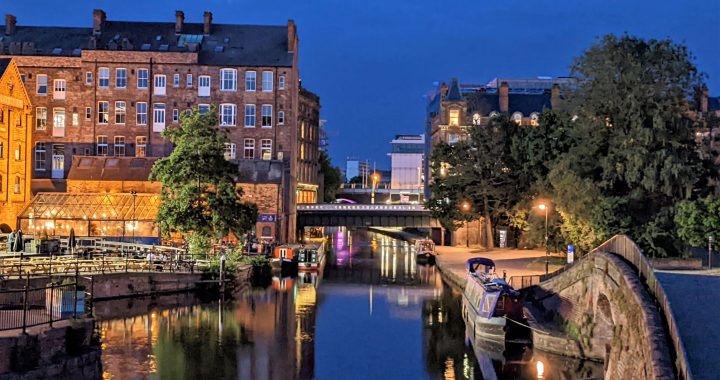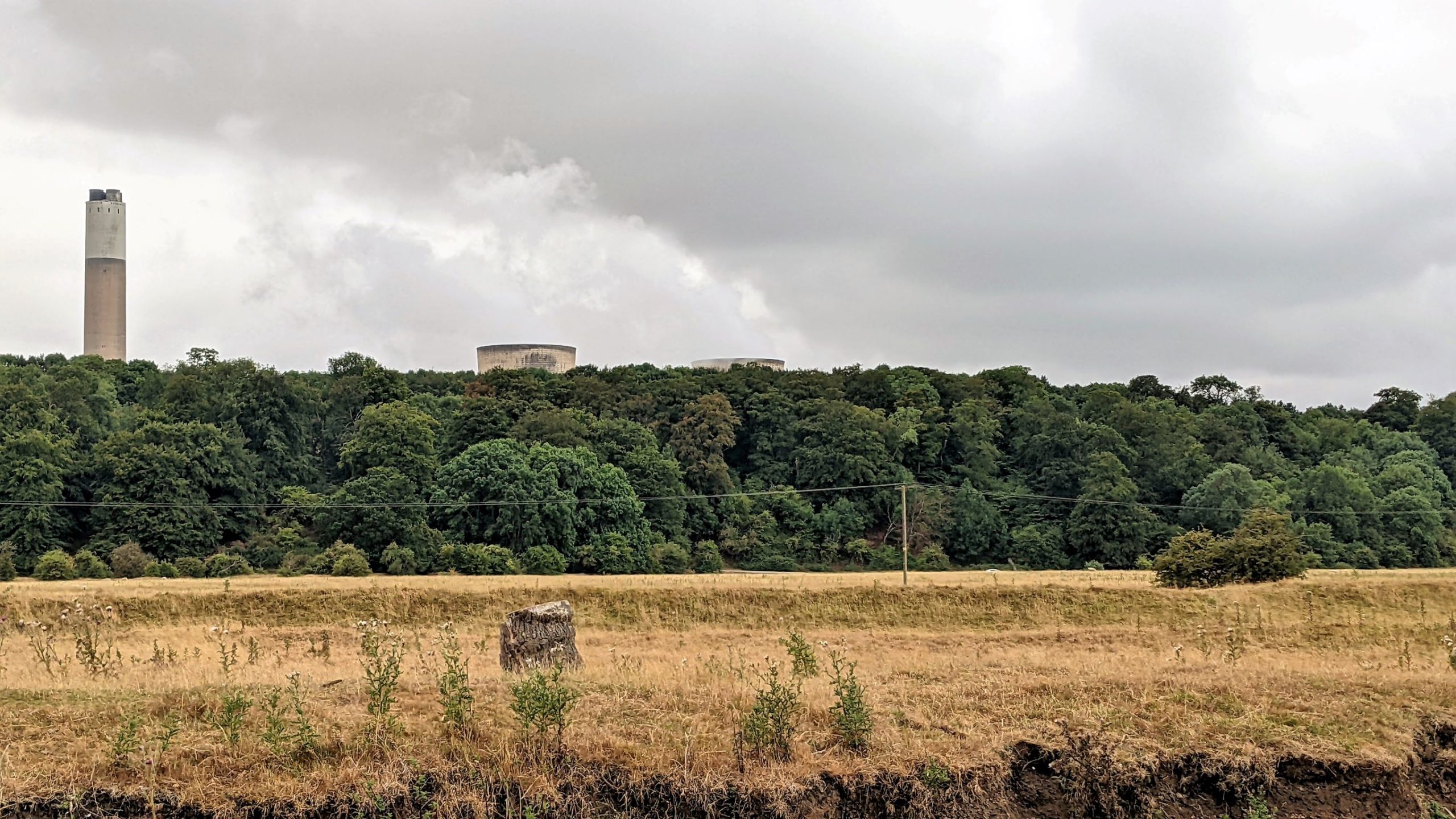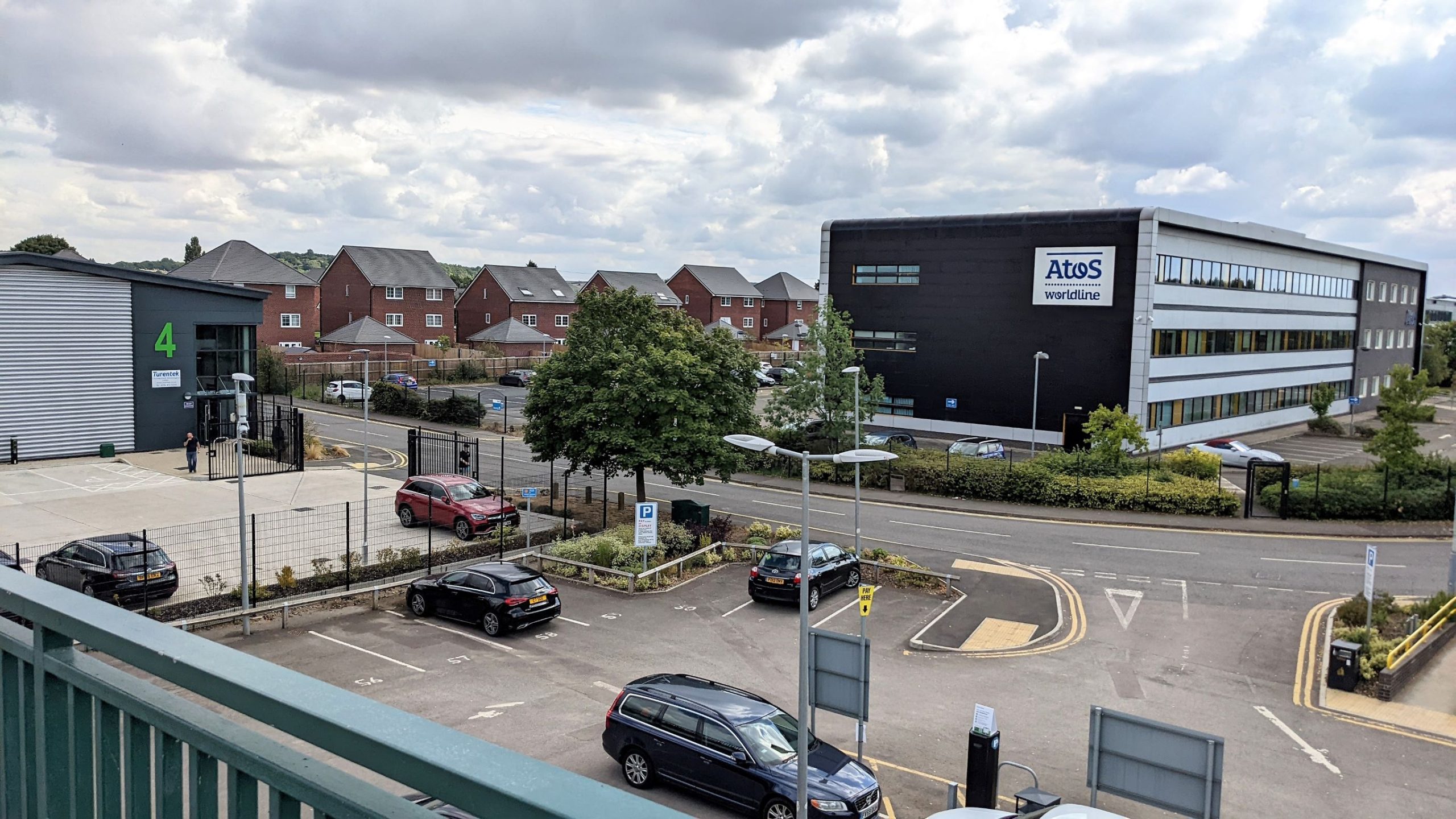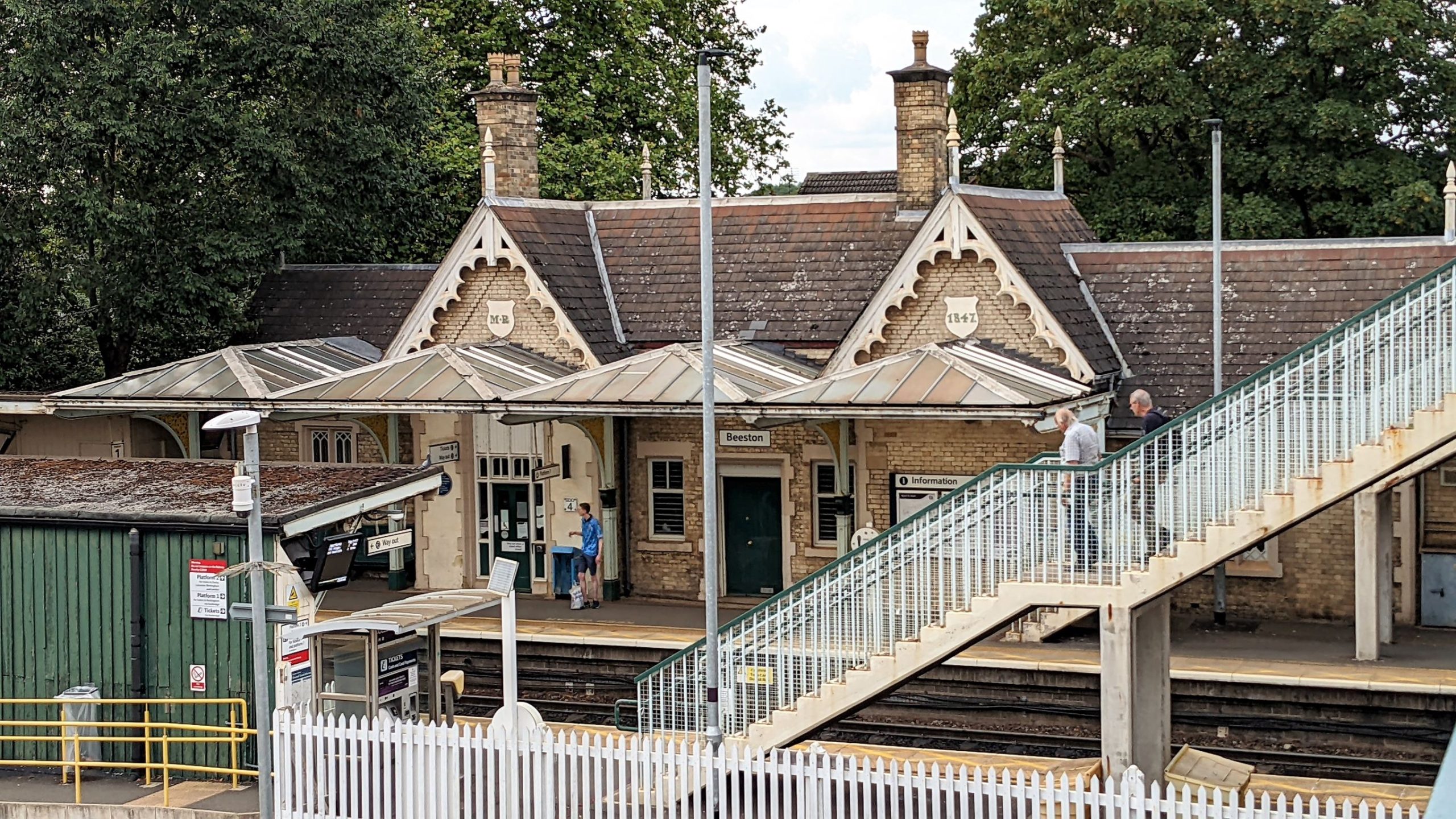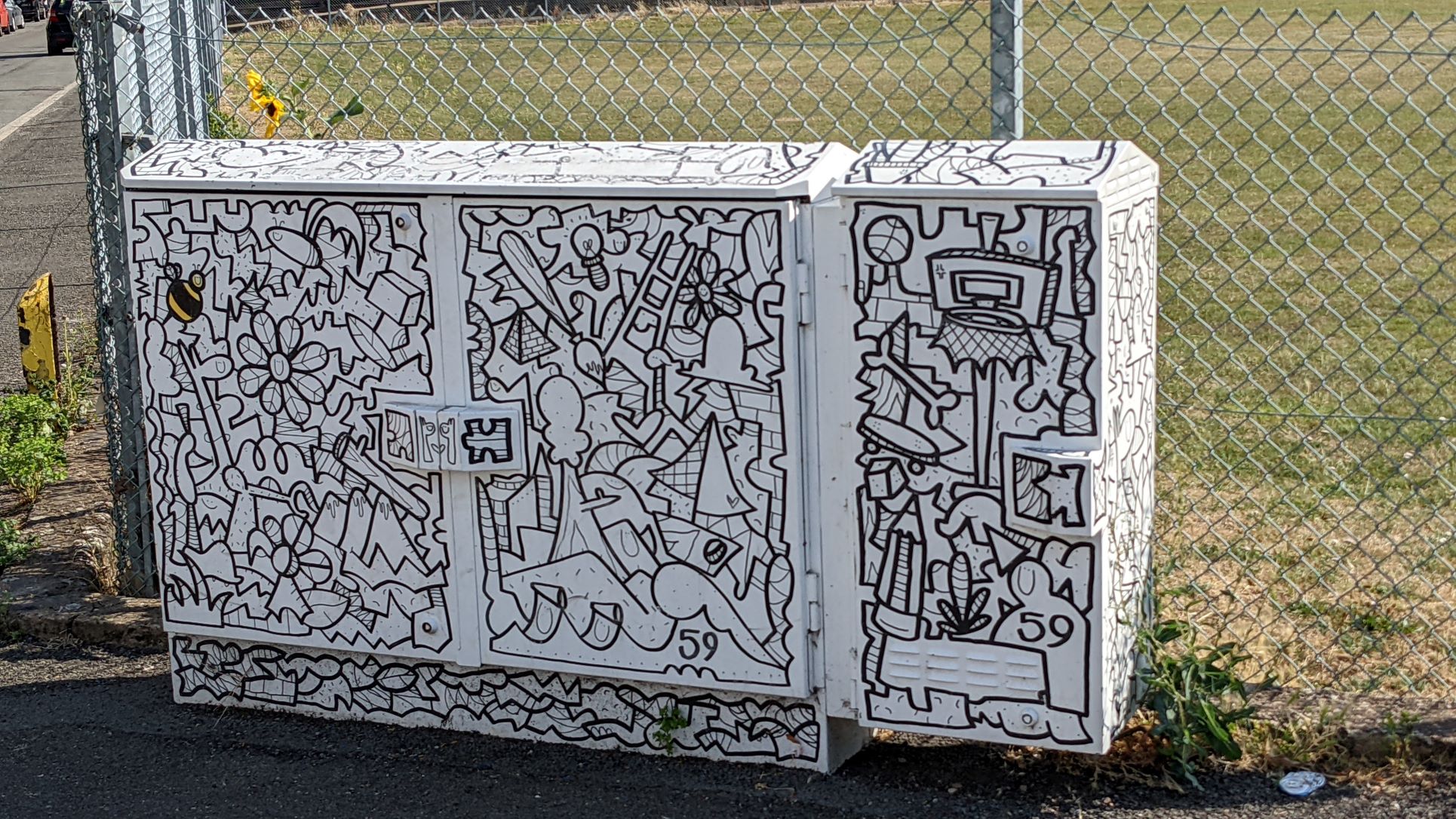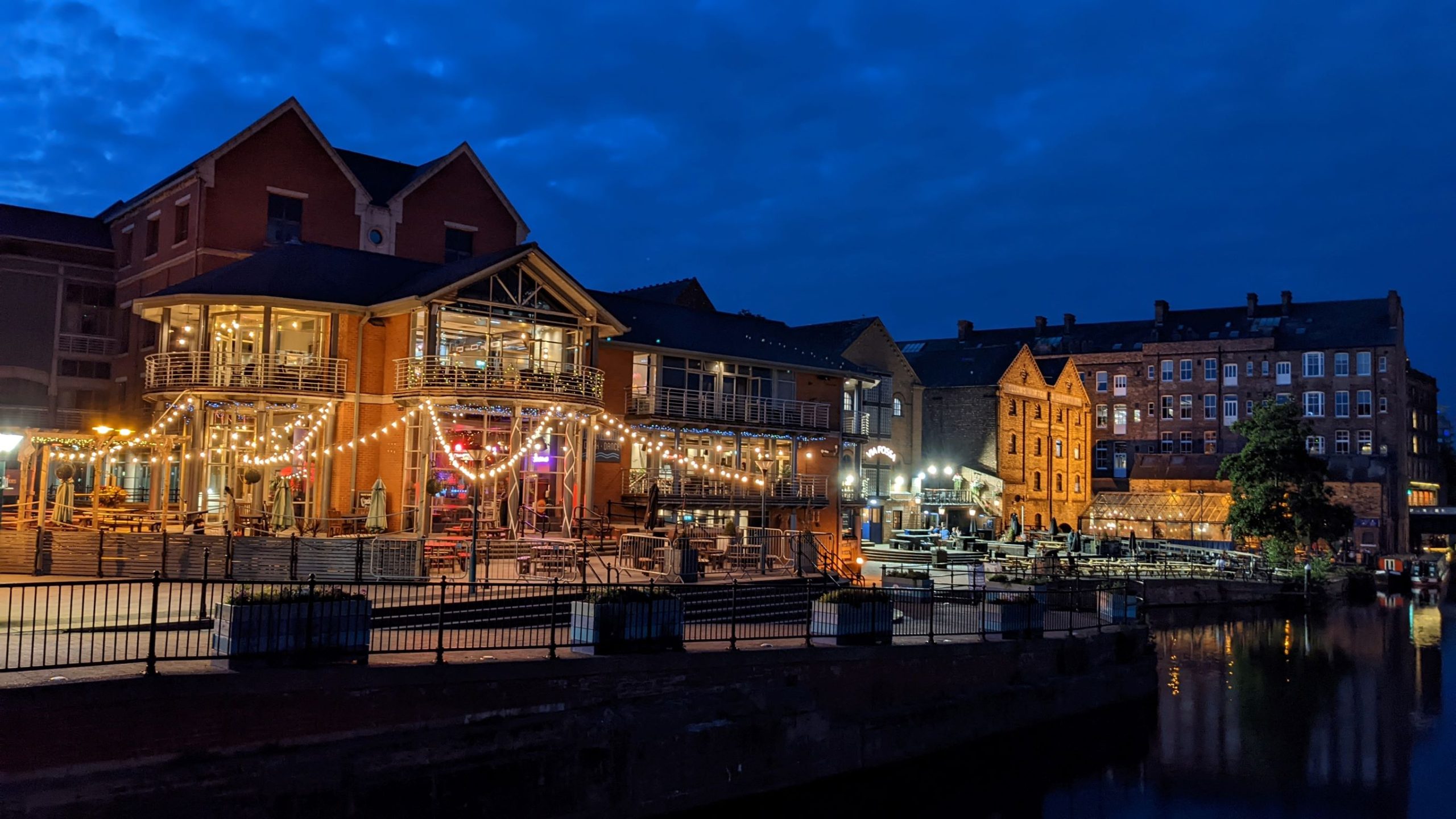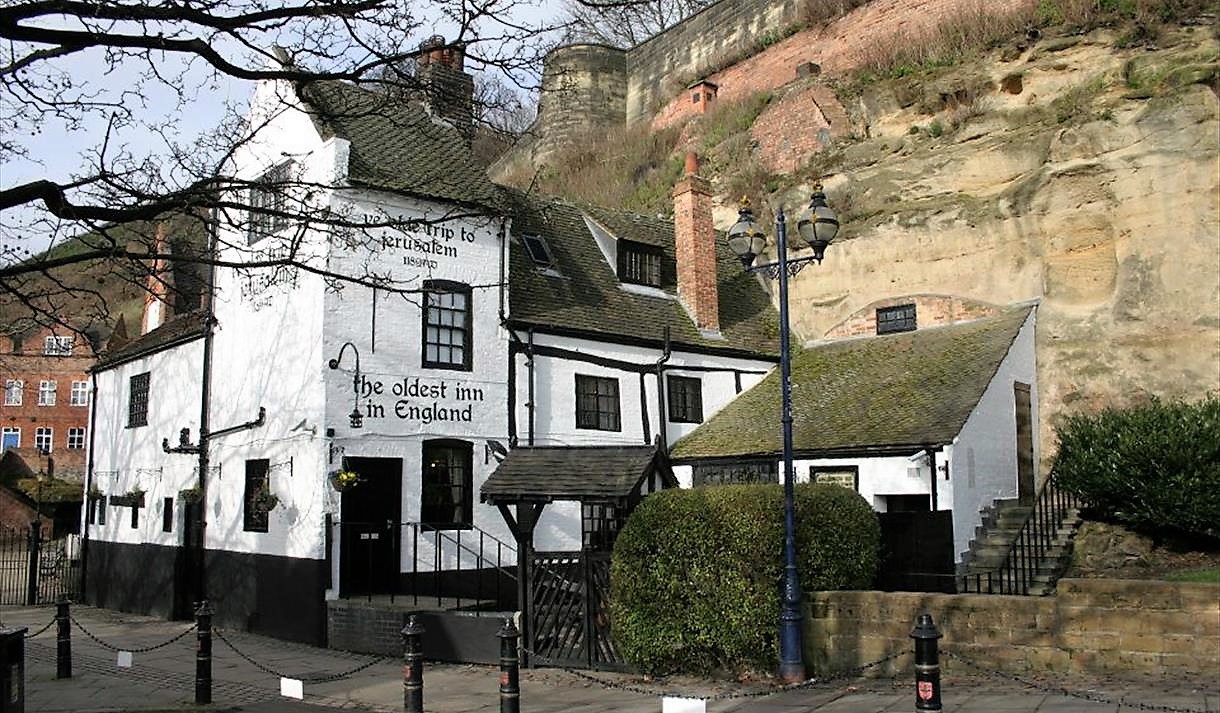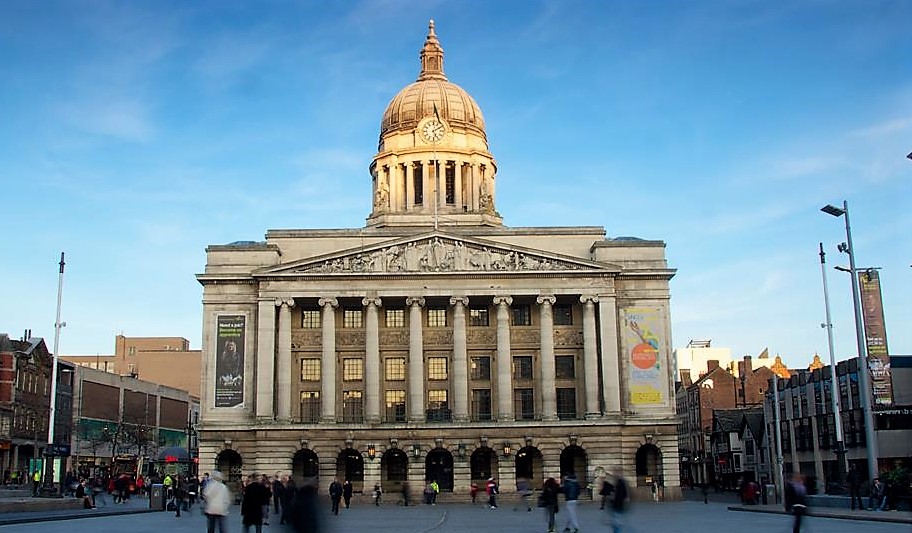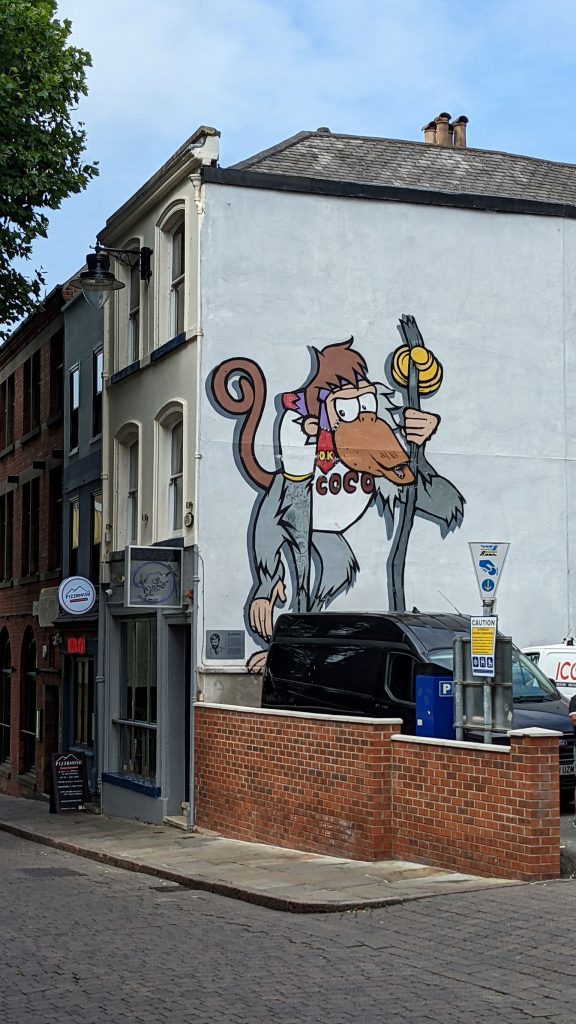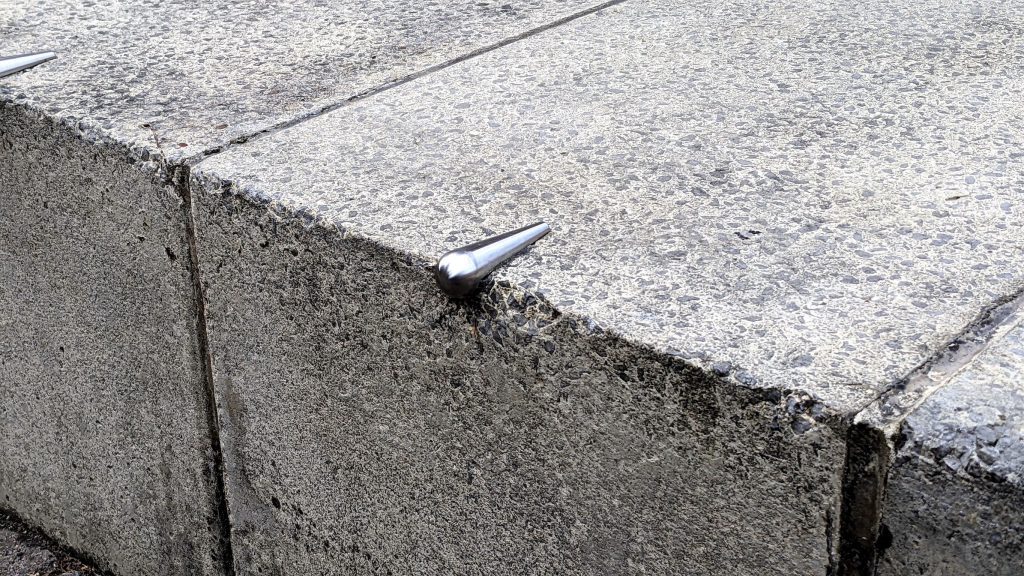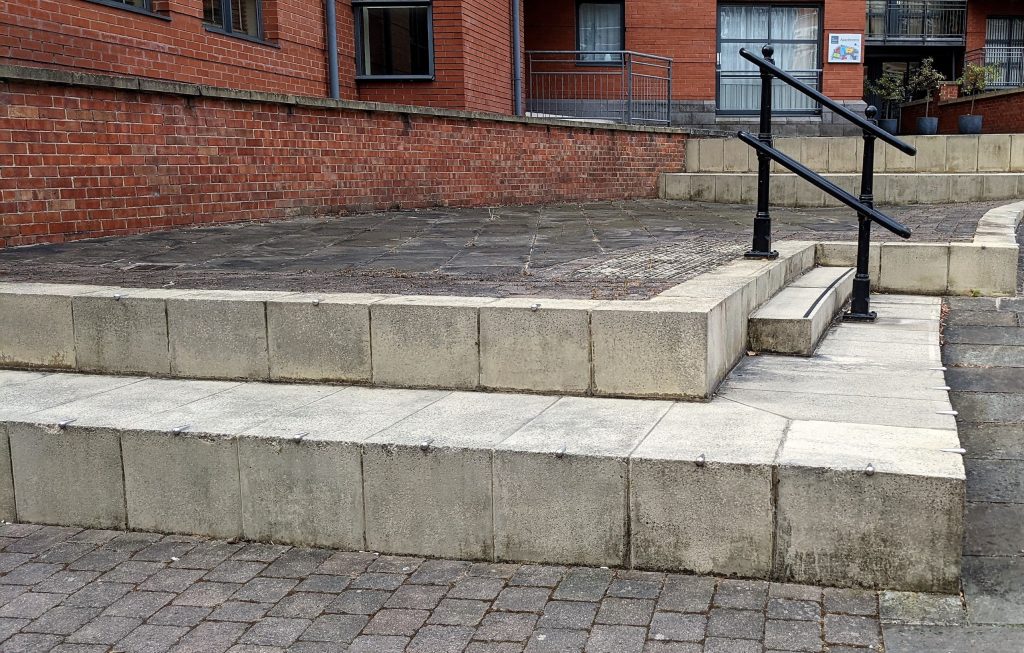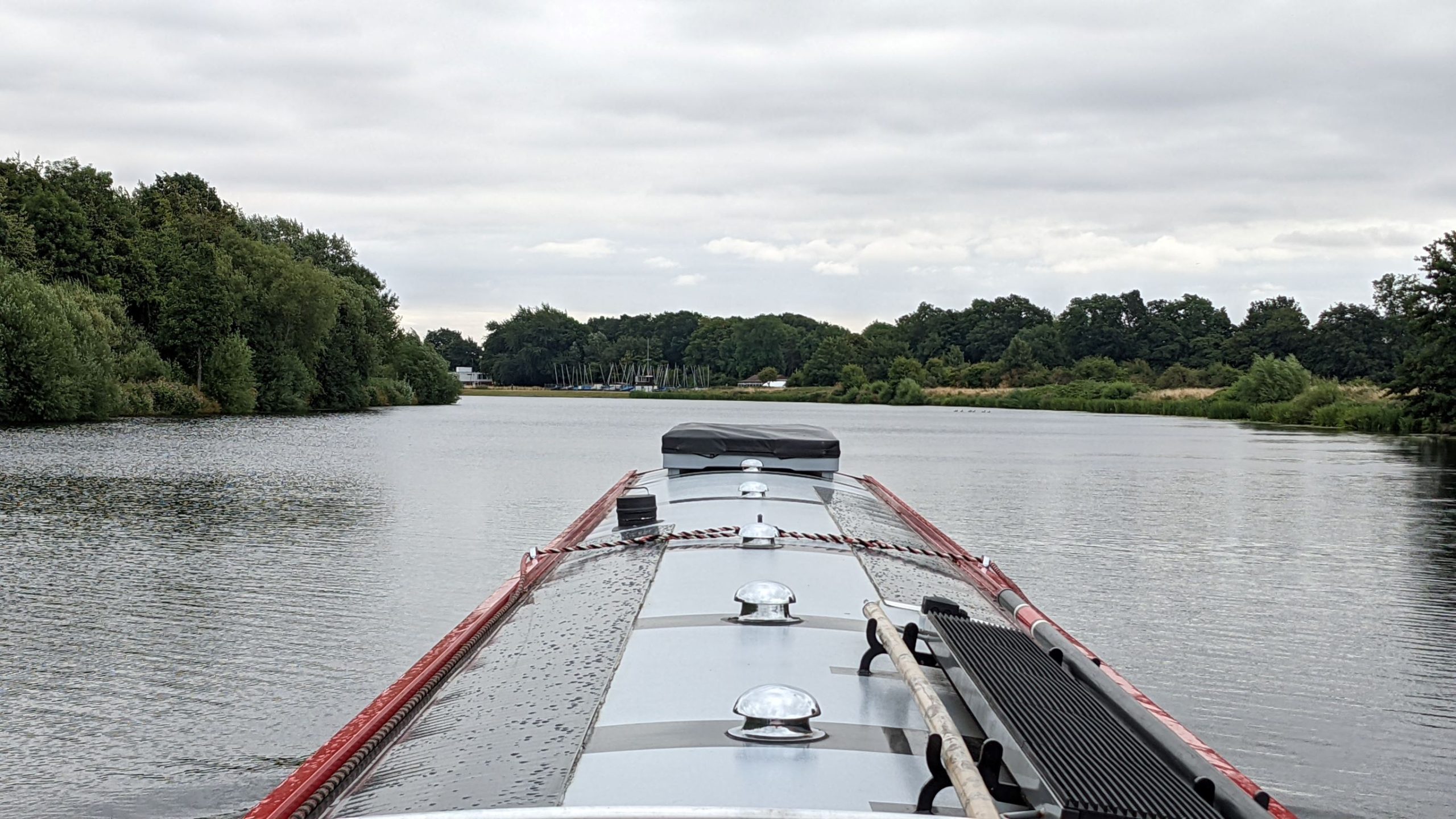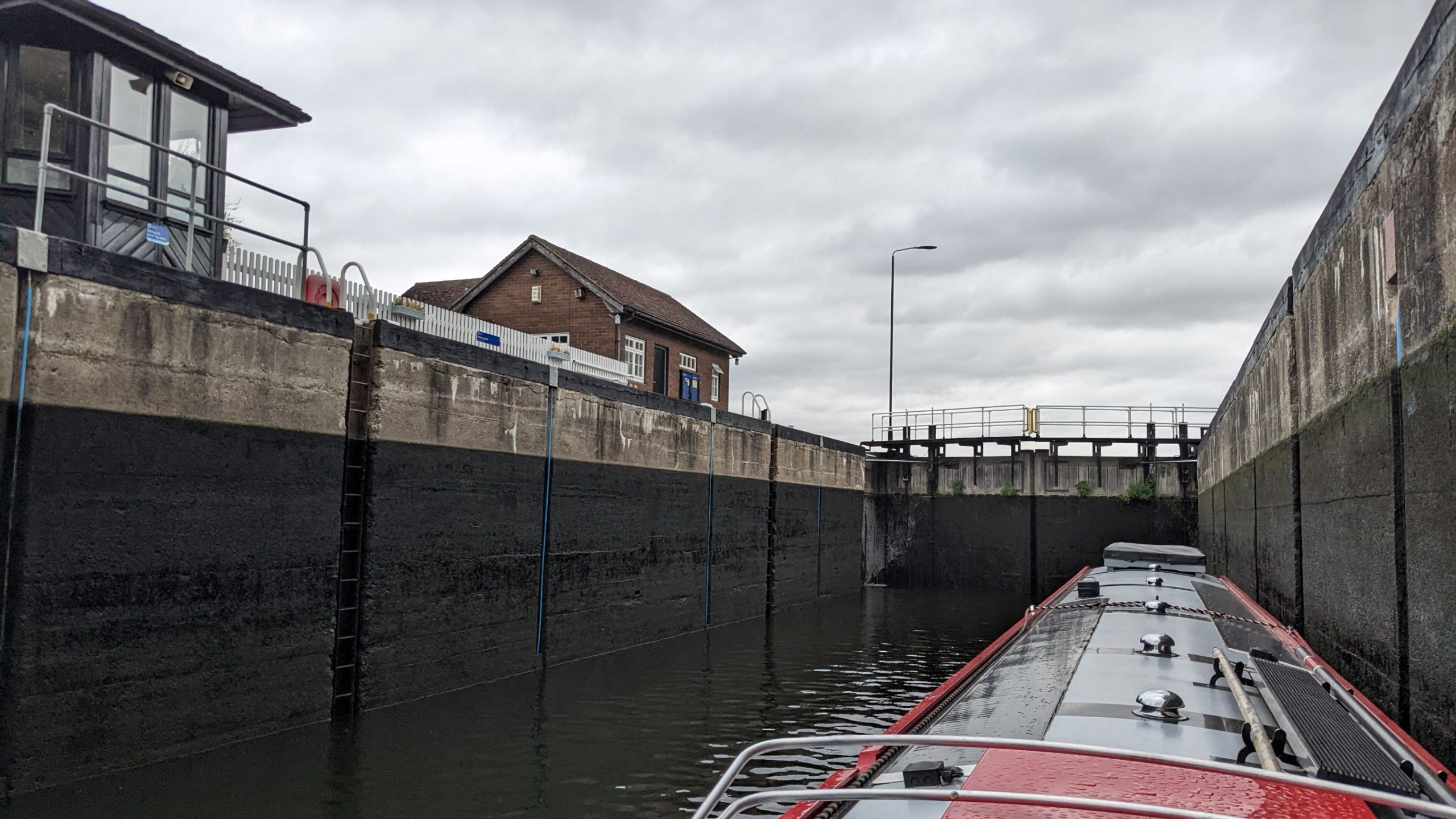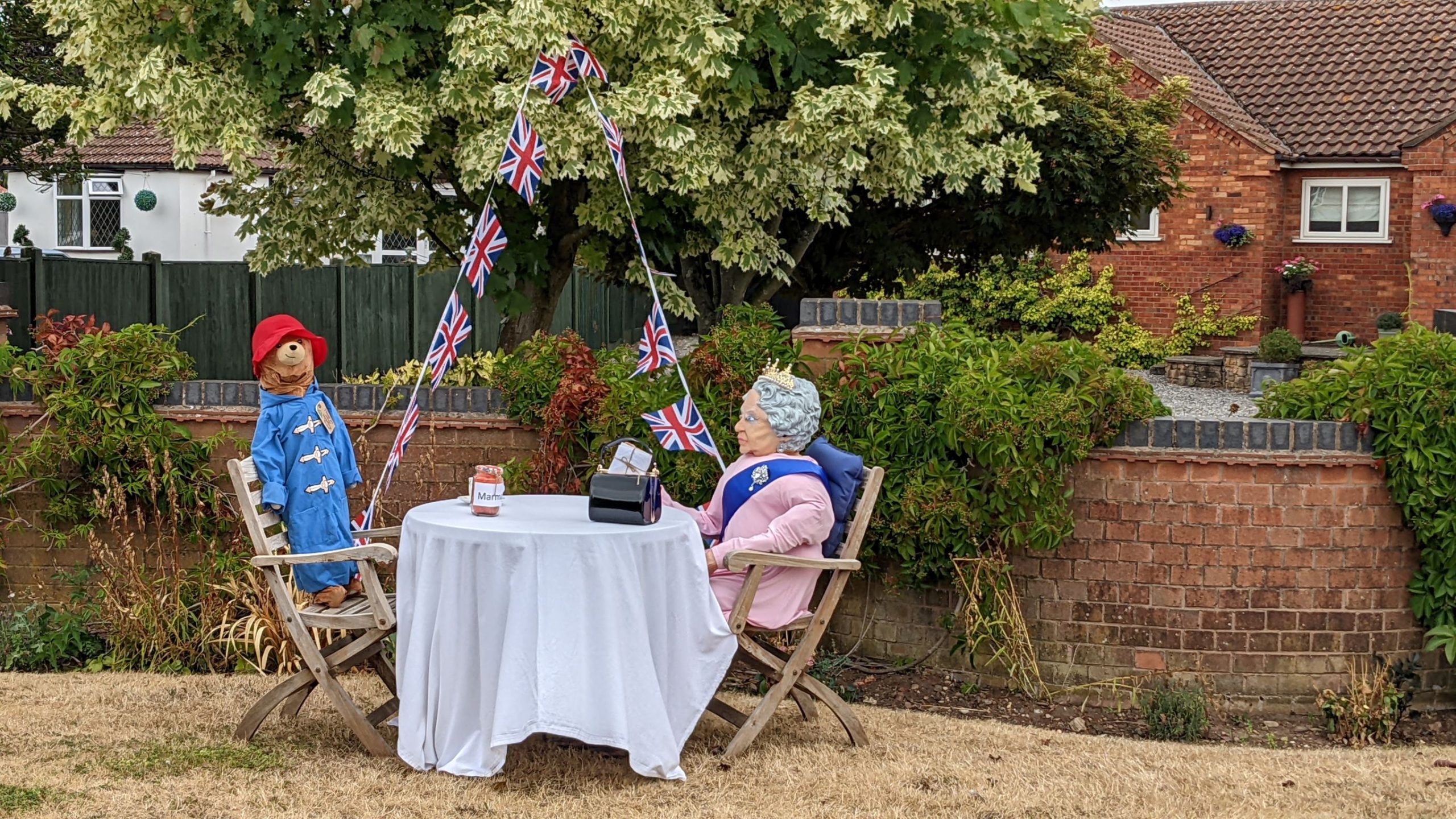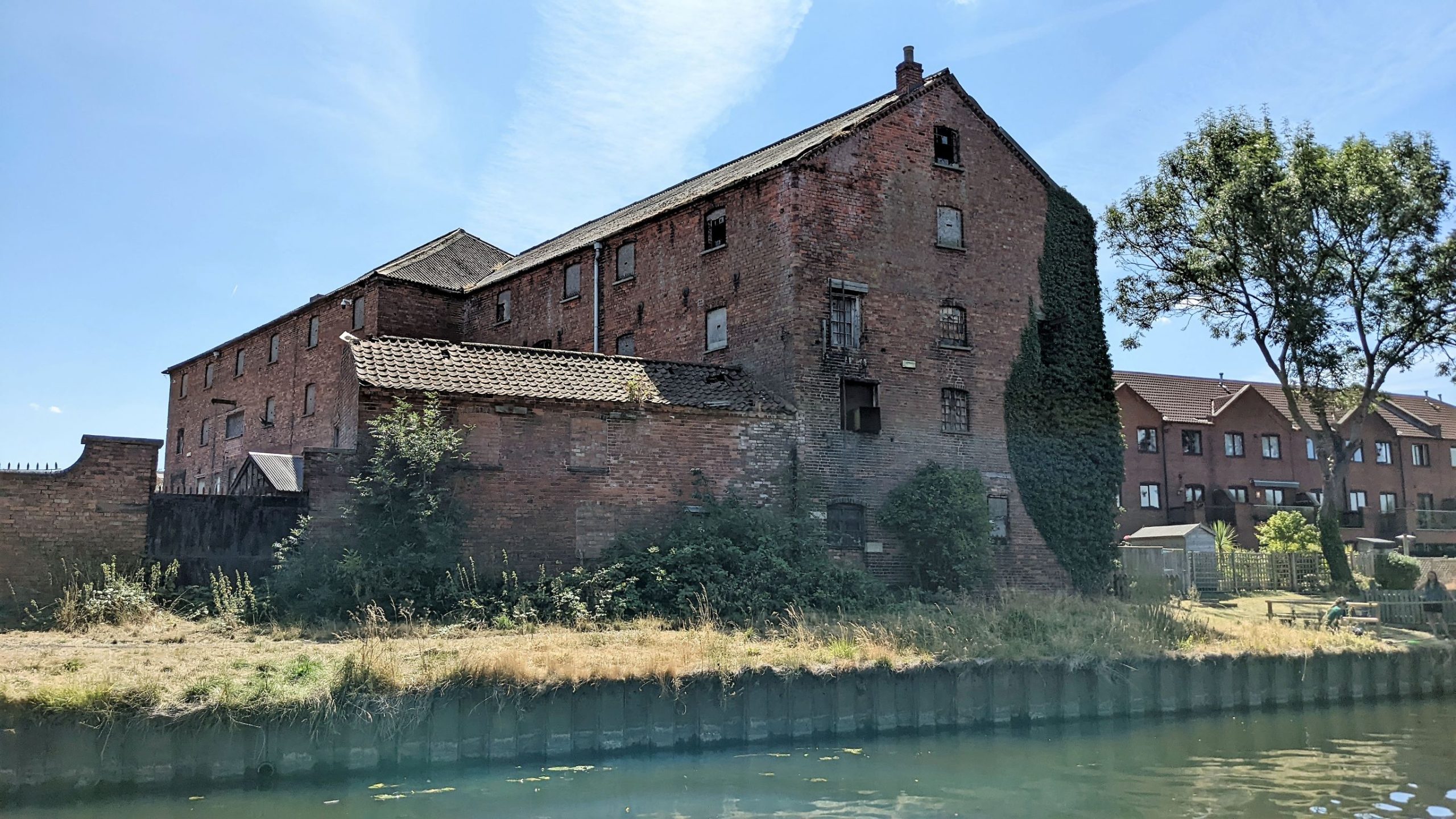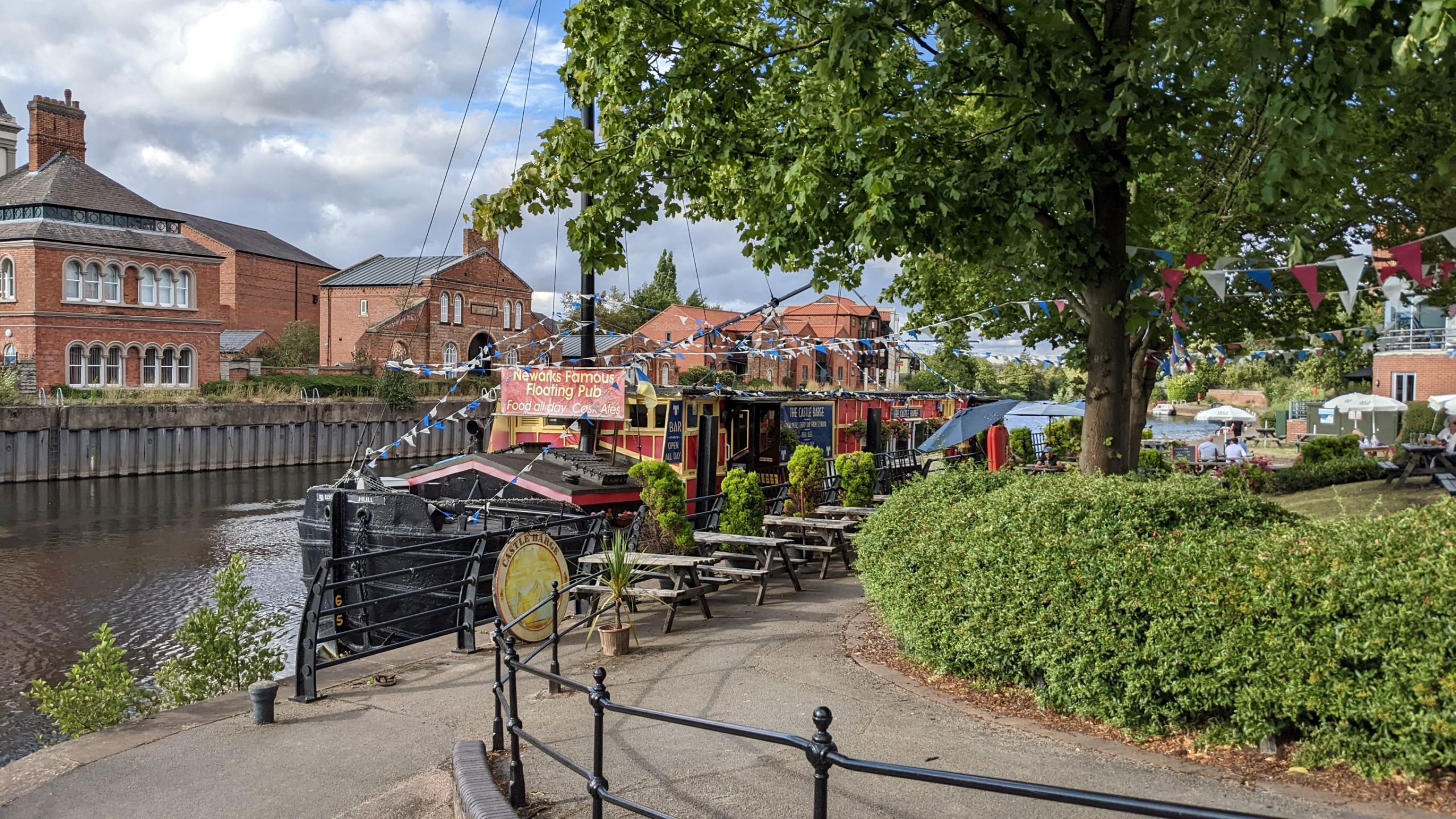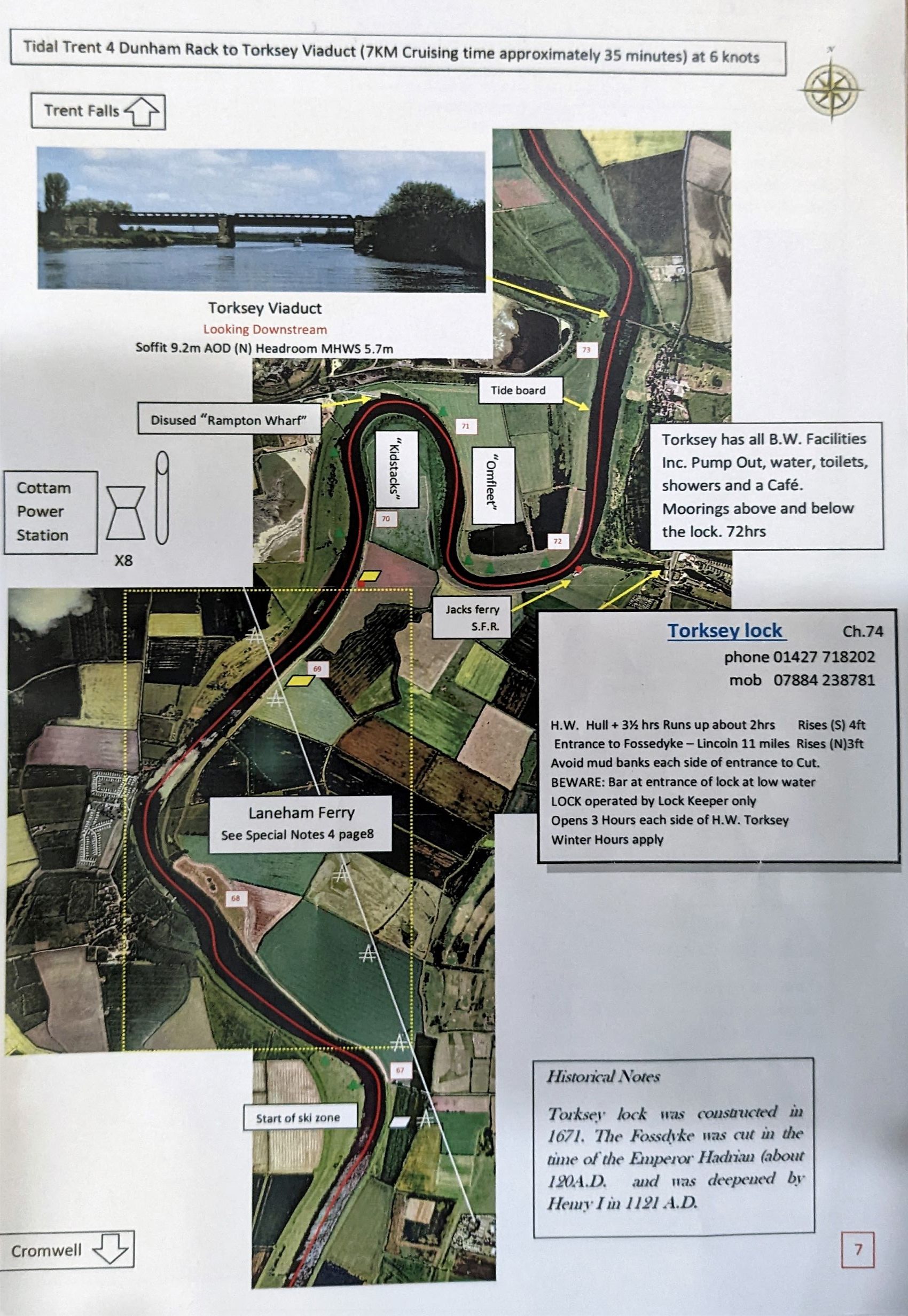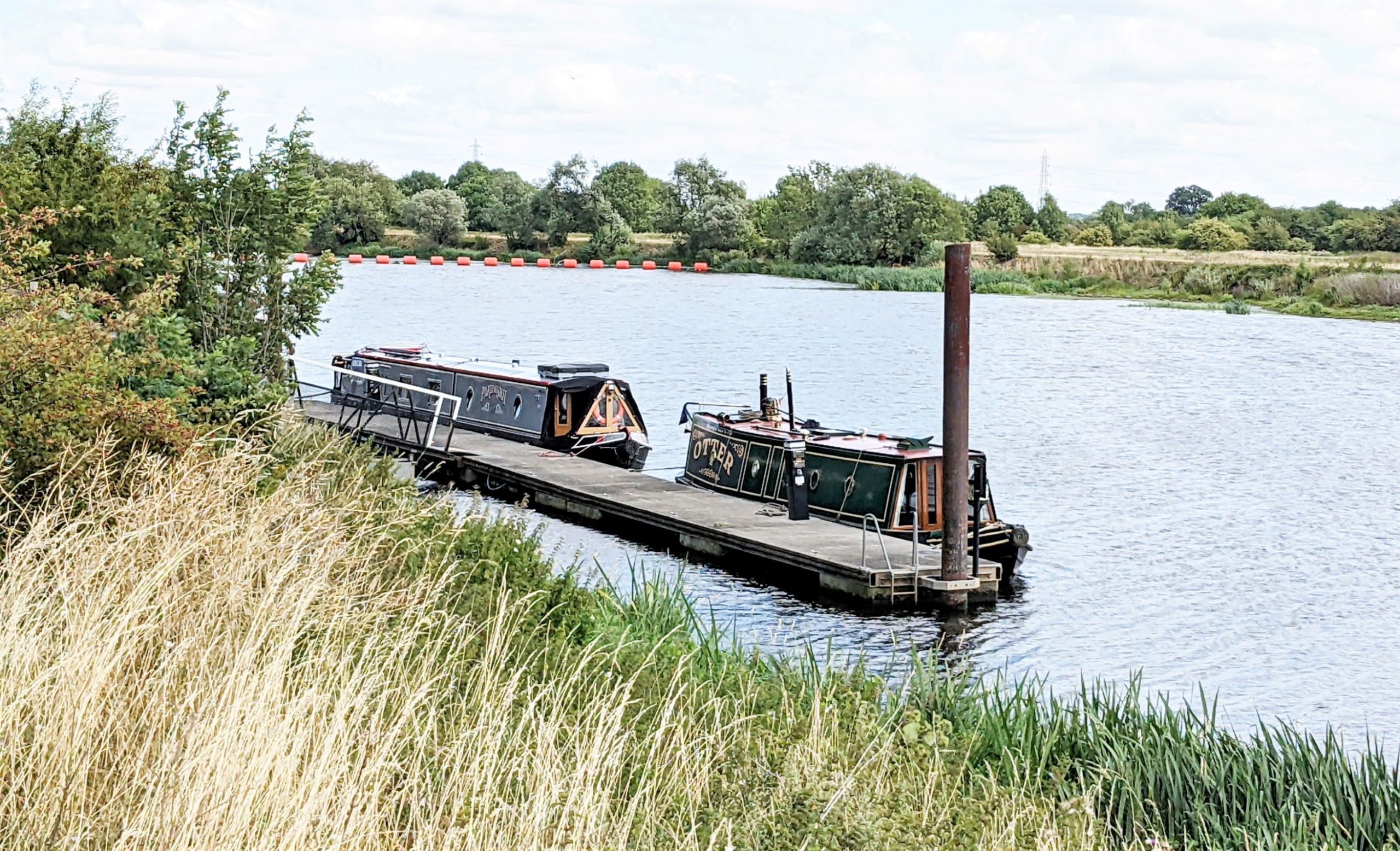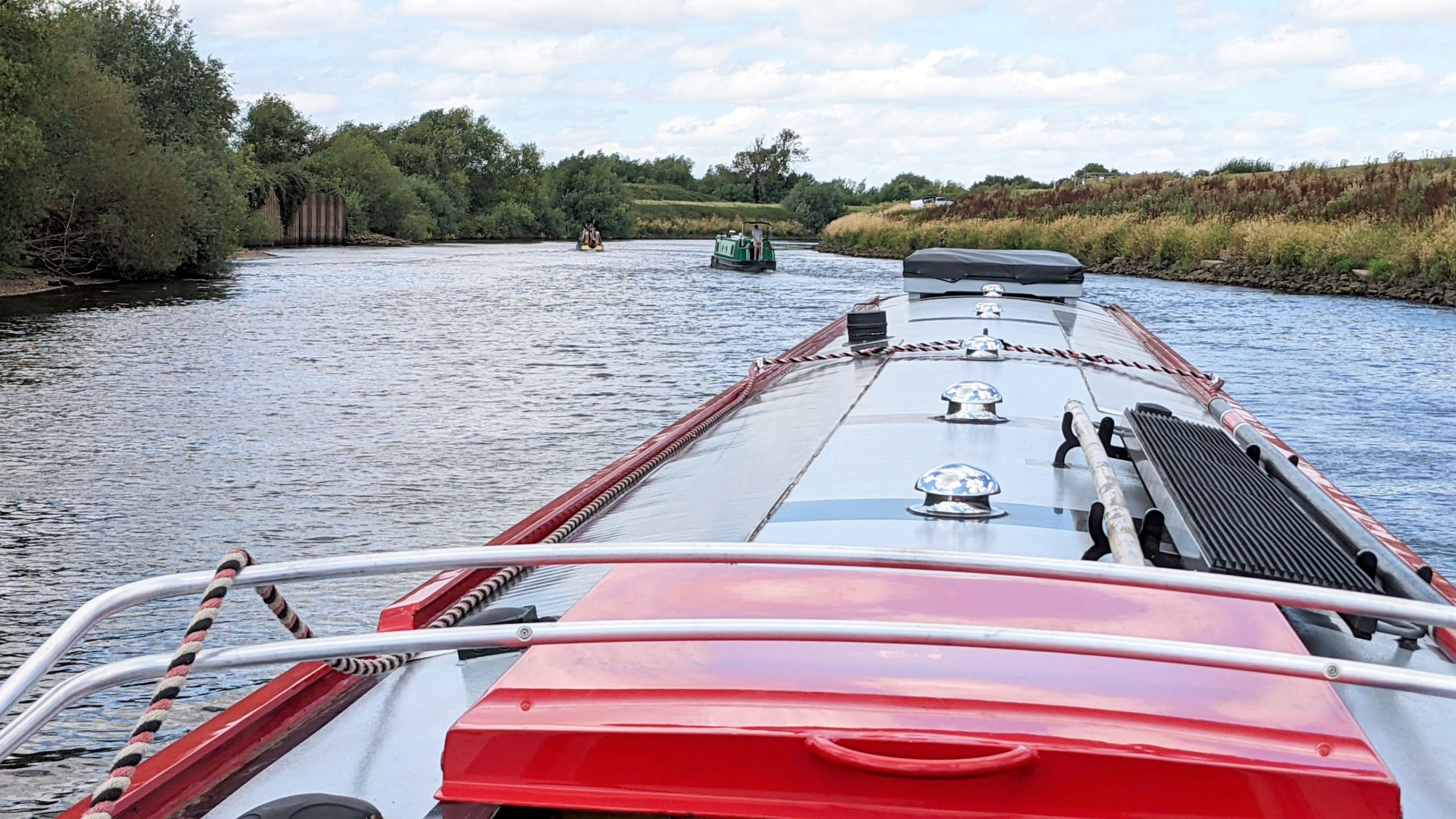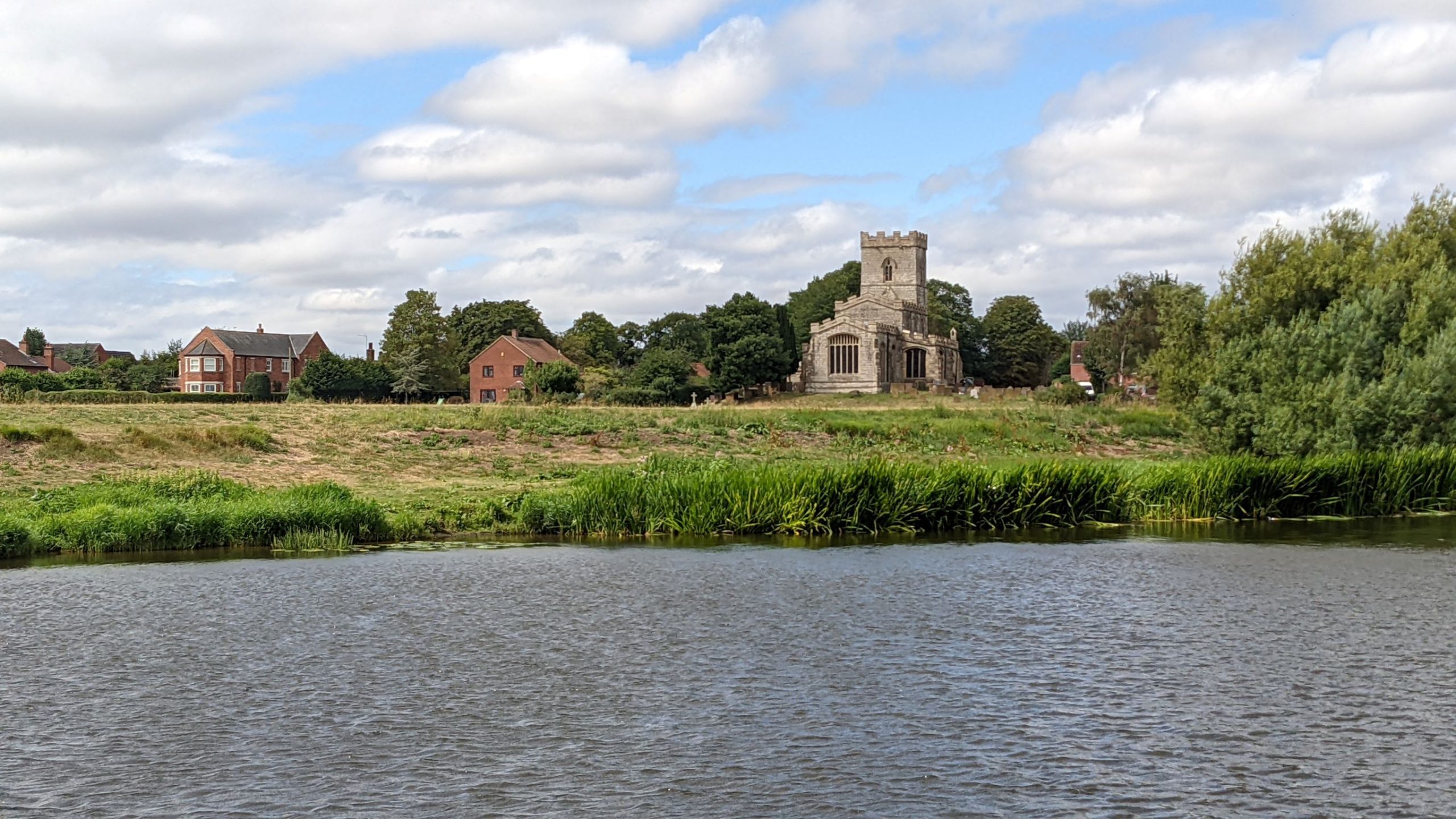Non-Tidal Introduction
On Tuesday twenty-sixth July, before dropping down to the river, we moved on to the water point and made it there just before our old friend "Temperanillo" emerged from the lock, looking for services. The previous day we had seen a notice that the Erewash was open to navigation again and he was heading up there to explore it.
We had been on the Trent before but only once, from Trent Junction to join the Trent & Mersey Canal a couple of miles to the west. When we set out on Tuesday we were heading downstream with some famous towns ahead of us. Eventually we would pass onto the tidal part of the river, which is fairly strictly controlled and has significant dangers associated with it. For now, however we were on the non-tidal Trent, which makes it sound very safe and canal-like.
To us, it already seemed very wide as we came out of Trent Lock where, sure enough, two boats were coming down past the junction just as we were trying to emerge. Allowing them to pass we fell in behind on the way to Cranfleet Lock. The ever-present cooling towers were still visible over at Redhill but in this direction, they were much better screened by the trees.
At the lock, one boat pulled in on either side, in such a way as to leave no room for us. It was a bit too windy to just wait in the channel but we managed to get a toehold at the front to take a line ashore and fend off the stern from the boats permanently moored behind the landing. Behind us there were now another narrow boat and two widebeams and the lock was still against us all. The lock, itself, was quite fierce and the single boat coming up was being ultra-cautious, opening each paddle an inch or two at a time to avoid being thrown around. In the end, it took us forty-five minutes to get through that one lock.
The rest of the trip was quite straightforward, despite a number of obstructions and hazards marked on the map. We only had about five miles to do before pulling into Beeston Marina for diesel. We received excellent service with comparatively cheap fuel and some good advice about where to moor. Beeston Lock was a bit weird as it was rather difficult to tell whether you were going up or down and it had special red paddles but no explanation other than an instruction to always leave them open when you left. We assumed it was because, as you go through this lock, you are transferring onto the Beeston Canal from the River Trent, which goes off down a very big weir. Sure enough, once through the lock, all the visitor moorings were fully occupied with some pretty permanent looking floating sheds. Beyond the next bridge, however, just as advised by the marina, there was plenty of room. It would be on the side away from the town but that suited us fine.
Beeston & Nottingham Canal
We had a look around Beeston in the afternoon but it just seemed like a big, industrial dormitory town with not much to attract you. We did find the Manor House and the area around there seemed a bit nicer but it didn't really appeal to us. Among the big modern warehouses and distribution centres
the railway station looked incongruously twee and old-fashioned.
As we came round through one of the new estates, on the way back to the canal, we noticed how they had attempted to smarten up the street furniture.
Back where we were moored, however, on the other side of the canal, the land between the Beeston Cut and the long loop of the Trent, up to where they are both crossed by the busy Clifton Boulevard, is given over to sports grounds, parks, woods and farmland. A track runs all the way round with some connections in between and it is very popular with walkers, runners, cyclists etcetera. It was peaceful enough, despite the passers-by, that we stayed there for another day before making the run into Nottingham.
As built, the Nottingham Canal ran from the Trent, below Trent Bridge, through Nottingham and then west and north to join the Erewash Canal at Langley Mill. The Beeston Cut was added just west of Nottingham to rejoin the Trent at Beeston and so bypass a section of particularly tricky navigation on the river Trent itself. The short section from the junction with the Beeston Cut through the city of Nottingham to Meadow Lane Lock and back out onto the Trent is all that is left of the actual Nottingham Canal and they are now often known as the Nottingham and Beeston Canal.
The transition from one to the other is, to all intents and purposes, invisible as you cruise along it. A couple of miles from Beeston Lock you pass the very large Nottingham Castle Marina, another Aquavista acquisition, with mooring right next to a large Sainsbury's supermarket just beyond. We stopped here, of course and while Sue was inside, Archie and I went to look at our options for mooring in the city. It had been suggested that where we were, just by the superstore, was not a good spot overnight. As we followed the canal down towards Castle Lock there were plenty of rings in the solid sides that should allow mooring all along this stretch. However, we later discovered a shelf below the water which made stopping there difficult. Beyond the lock there were a handful of moorings either side of what had once been an arm and is now a decorative feature outside the law courts. More rings were provided beyond Carrington Street Bridge but that area looked rather grim and there was no-one else moored there, which I took as a sign that it wasn't a good spot.
Returning to collect Sue and the shopping, we first tried mooring above the lock but discovered the issue with the shelf. Dropping down through the lock we could see that all the official spaces were in use but there were rings just before the footbridge. Technically, we suspect that this may have been part of the lock landing but there was a lot of space above us, so we took the chance and tied up there. In the end we stayed there for two nights and nobody seemed bothered by our presence. For our part, we had a busy footbridge not far in front of us, three very busy looking pubs fronting the canal just beyond that and, as it turned out, the warehouse opposite was actually the comedy club, which was in full swing on both nights. We thought this might all be very disruptive but in practice we experienced no interference and didn't suffer unduly from noises off.
On Thursday afternoon we went into Nottingham centre and got a guide from the Visitor Centre that had two self-guided walks around the city and on Friday morning we set off to see some sights. The city centre lies to the north of the canal and is dominated by the castle, an impressive presence built on a huge natural promontory. It prides itself, as does the city, on a strong association with rebellion and dissent, on one side or another. The legend of Robin Hood is an obvious one, as is the first Richard's campaign to put down King John's rebellion. Richard III rode out from there to Bosworth Field (or at least, somewhere near Bosworth Field). Charles I raised his standard there, only for the city to turn Parliamentarian as soon as he left. Nottingham was also a hotbed for the Luddite movement. In consequence of being at the heart of all this turmoil, we gather that there is almost nothing of the original castle left. We couldn't see for ourselves, of course, because they don't allow dogs in the castle itself.
Just below the castle is a pub that claims to be the oldest in England and perhaps, to have one of the strangest names: "Ye Olde Trip To Jerusalem". The pub is referenced everywhere you look and has become so celebrated that it is sometimes hard to tell whether the pub is famous for being by the castle or the castle is famous for being by the pub.
Our first walk took us out to the west, past the castle, the old General Hospital, Wellington Circus by the Playhouse and beside The Park, a nineteenth century residential estate built on the castle deer park. The walk takes in Park Tunnel built to allow horse drawn carriages access to The Park from Derby Road. The tunnel was to have a maximum gradient of 1:14. On completion of its construction it had a gradient of 1:12, rendering it completely useless for its purpose. How many of us have been involved in projects like this? In this case, however, the architect did not get paid at all!
To finish, it came back down Derby Road to, yes, Maid Marian Way and crossed down Chapel Bar and Angel Row to the Old Market Square. We paused here for refreshment, hoping to find a range of charming cafes and tea shops overlooking the market square. No such luck. The square, itself, was filled with some sort of children's funfair, presumably set up for the summer holidays and full of their squealing and screaming client base. There were a few pubs but otherwise it was a sea of national and global chains, from Subway and Starbucks to the recently resurgent and ever-present Gregg's empire. We chose The Bell Inn in Angel Row which, funnily enough, also claims to be the oldest pub in England. They base this on an assertion that "Ye Olde Trip To Jerusalem" was only a brewery to the castle and not a pub until after The Bell Inn was established. However, they only cite Time Team as the authority for this, so perhaps the jury is still out. Either way, they would serve us a coffee and a bacon roll before we embarked on the second walk.
This one was a bit tighter, heading out to the east from the Old Market Square and taking in The Council House and the Exchange Arcade, Shire Hall and the Lace Market.
The Council House has a magnificent position overlooking the Old Market Square but the lovely colonnade to the front, behind two large, stone, art deco lions that guard it, now seems to be, primarily, an informal dosshouse and is best avoided in clean shoes.
Shire Hall now houses the National Justice Museum but was a courtroom, having been used for various official purposes since Norman times. It was only re-built in the late eighteenth century after, in seventeen twenty-four, the courtroom floor collapsed, allowing several people to fall into the cellars below. It is believed to have been the only site in England where you could be arrested, sentenced and executed without leaving the building. The last public hanging was in the mid nineteenth century and the gaol was closed a decade or so later. It was surprising, however, to see that it continued as Nottingham's civil and criminal courts until nineteen ninety-one, when they transferred to the massive, modern complex by which we were moored.
The street art wasn't anything like as good as Leicester's, with this solitary example:
We did find a mystery on the way. In the square where the General Hospital has been converted to apartments, in the stepped area all around, we found these metal teardrops embedded.
They clearly aren't going to deter people from sitting on the steps but we have since seen them in other, similar settings. If anyone knows what the point is, we would love to hear it
Back On The Trent
On Saturday, thirtieth July, we set off fairly early for Meadow Lane Lock, taking in a sharp ninety-degree bend on the way, to leave the Nottingham Canal and drop back down to the River Trent.
The water seemed wider, still, this far down and we made sure to wear our lifejackets. Even though we were still on the non-tidal reaches there was no mistaking the power of the river.
Leaving Nottingham, near the racecourse, the Sea Cadets have an impressive Training Ship with some sizeable artillery.
Then the section along Holme Pierrepoint runs past the National Watersports Centre and there are bodies of water all around the main course of the river. We had a lockkeeper to help us through at Holme Lock.
Further down at Stoke Lock we found a small boat facing upstream on the lock landing. However, they were about to turn round and not only came through the lock with us but also worked the whole thing for us. We were planning to moor up at Gunthorpe, just before the next lock and on that short stetch had a couple of reminders of the difference in cruising on a river. Taking a bend too close on the inside and hearing our baseplate start to scrape on a shoal was a useful reminder of what could go wrong and how easily, if you lose concentration. Shortly after Stoke Lock, in a moment of inattention, I let the boat drift too close to the inside of a bend and we briefly shoaled on a mud bank before moving far enough away. As we arrived at the mooring pontoons at Gunthorpe we could see there was one space on the inside and at the far end. Foolishly, I tried to pull past and then reverse up into the space against the current. Unsurprisingly, this did not go well. We had to disentangle ourselves from the reeds, pull out into the river again, turn round and come back in again against the current, which allows you to maintain some steering. On the canals, current just isn't a factor. At least on the river there was plenty of room to turn around.
It being our wedding anniversary, we had thought we would go across to The Unicorn pub, just across the green from the moorings but when we went to reserve a table, we were told they were fully booked. In truth, they were half empty but didn't have enough staff to take on further covers. Happily, we discovered a very good Indian restaurant just at the other end of the green so, after an invigorating walk across to Caythorpe, where they were still celebrating the Platinum Jubilee,
we returned along the riverbank and settled for a pint in the pub and an excellent takeaway from the restaurant.
Ahead of us was Newark, the last significant town before we would enter the tidal river at Cromwell Lock. We would need to book passage through that lock in advance, as well as booking the lock where we would leave the river again, as there are no real moorings along it. We decided that we would stop short of Newark, at Farndon, on Sunday night and then spend a couple of nights in Newark itself on Monday and Tuesday. Accordingly, we booked out of Cromwell Lock for Wednesday, third August and through Torksey Lock the same afternoon. The timing has to be determined by the time of the tide, so we were advised to be ready to leave Cromwell from one o'clock. The time at Torksey, of course, would be determined by the length of the journey.
Having organised that on Sunday morning, we set off through Gunthorpe and Hazelthorpe Locks to arrive at a three-day mooring pontoon at Farndon. As we arrived, we could see one space left on the end and this time managed to get on quite easily, although it was slightly complicated by the popularity of this site. On a sunny, Sunday afternoon the two pubs and cafe are busy and the common around them is a great attraction for some families with inflatables to launch them from the beach just in front of the mooring pontoon and splash about in the water. They managed to clear out of the way as we arrived but were back in full force as soon as we had tied up. As well as day visitors there were plenty of caravans and camper vans, so it was good to see that there was a locked gate segregating the mooring pontoons from the shore.
Beside the busy car park and pubs at Farndon was a Woodland Trust site that was ideal to give Archie a run on Monday morning, before we went into Newark. A really nice area of little paths through the woodland and some open areas to run in with only a few people about. Apart from getting bitten on the hand by some sort of fly, it was a really pleasant stroll round.
Back on the boat we headed a very short way downstream to call in at Farndon Marina to top up with diesel. The service bay was occupied when we arrived but we didn't have to wait long for it to free up. The diesel wharf is on the short section of the entrance before a T-junction to go left or right into the main marina. We reversed in so we didn't have to bother with that. We did notice a narrowboat, "Christopher" moving around across the T-junction but the driver wouldn't meet our eye or give any indication of his intentions. As we prepared to leave it became apparent that he was also on the point of departure, so we waited. As he passed us, I managed to get him to tell us that he was heading down to Newark and let him know that we would be following him down. Despite this, when we got to Newark Town lock, we found it turned against us. He had gone through on his own without telling the lockkeeper that we were just around the bend. Quite an unusual degree of churlishness, in our experience.
On the way in you can see the spire of Newark Church as a real landmark as you pass a quite sympathetic development of new houses next to some old warehouses.
We waited for the lock to re-fill and went through to find the moorings on the left bank opposite the town. We were lucky to arrive and find a space available on the pontoon opposite the town, rather than having to tie up to a high stone wharf with a lot of foot traffic. At first the spacing seemed awkward and it looked like a water point, so we started to pass. Having worked out that it would work we forgot, once again, the need to turn round and approach upstream, so we had some floundering around for a few minutes, failing to reverse, before we went on to do that and finally got into the berth.
After lunch we went to the Visitor Centre, which turned out to be shut until Wednesday, despite everything it advertised to the contrary, so we had to resort to finding a town walk to follow the next day by downloading something we found online. Many of the shops and businesses were closed on Monday and many of them on Tuesday as well. The people we met seemed very friendly but also a bit odd and our impression of the place was of a town with rather a strange mixture of being both prosperous and run-down. It certainly looks grand from across the bridge.
Archie had an important appointment at five o'clock with Vets4Pets, in Pets At Home, so we had to hurry over to the Retail Park out of town. He needed a kennel cough inoculation at least two weeks before he would go to the boarder at the beginning of September. We thought we might have trouble arranging this but it turned out to be quite simple when we phoned ahead from Nottingham to arrange it, a few days beforehand.
There was mooring all along the town wharf on the other side of the river but there seemed to be quite a rough side to it, with plenty of shouting and drinking going on there all afternoon. We felt we were far better off on our side, away from the passers-by. As if to prove it, at about six o'clock, we watched one swearing misfit take one of the lifebuoys off its stand, tear off the rope intended to help haul someone to safety, drop the ring on the ground and walk off with the rope, still shouting and swearing. Whatever else had gone on it was enough for a pair of constables to come by the next morning and start talking to some of the people moored along there.
On Tuesday morning the insect bite on my hand, that the day before had been itching and a bit red, was very red and the hand was extremely swollen. In the end, I decided I would have to at least approach a pharmacist for advice. They gave me some antihistamine tablets but having looked at it advised me to go to the Urgent Care Centre at Newark Hospital, twenty minutes' walk the other side of the town centre. Here, they handled the reception and triage very quickly but I had an hour to wait before I could actually see a nurse. In conclusion, yes it was definitely infected and they prescribed a seven-day course of antibiotics to go with the antihistamine tablets. By the time I got back to the boat it was already lunchtime but at least Sue had had time to run two loads of washing.
The leaflet we had downloaded had four walks around Newark, each based on a different period. It was originally written a decade or so ago and hadn't been kept up to date. There was no integration between them, which meant covering the same ground multiple times and a lot of what we could see was the result of a specific effort made around the turn of the millennium, that had then been allowed to decay. It is a common theme, repeated in towns and villages everywhere, where improvement and promotion efforts, made to great effect at a point in time, are rendered near worthless because there was no thought or provision to ensure it would be monitored and maintained in the future. It certainly mirrors what I have seen happen repeatedly in corporate life.
We chose two of the four trails and followed Civil War Newark quite diligently. Georgian Newark failed to hold our attention, however, and we trailed off halfway through. Instead, we called in at the Castle Barge floating pub on the town quay for a drink in the sunshine, having established that there is actually no reason to avoid alcohol while on a course of penicillin. Medical good news for once.
Riding The Tide
Being on the rivers has its challenges, with much wider expanses of water, limited moorings, quickly changing water levels and powerful currents. However, the real dangers lie when they get closer to the sea and are subject to the ebb and flow of the tides. One obvious example is the presence of large and dangerous shoals and mudbanks, that are easily overridden on the flood tide but lurk close to the surface or are exposed at low water. The change in water level is dramatic and highly variable, as are the different strengths and direction of the currents. There is even the issue of much larger commercial craft that may be operating in the same stretches of water and have to be given priority.
The upper reaches of the Trent are protected by Cromwell Lock. Beyond there, the tide holds sway unchecked. It is necessary to book passage through the lock and the lockkeepers will advise what time they expect the water to be right to let you out. It seems here that the main issue is not the state of the river at Cromwell, itself. Rather, they will base the time to depart on when the tide is moving in the right direction, when there will be sufficient water to get back off the river where you intend to exit, by the time you get there and with enough depth along the way to allow you to negotiate the potential obstructions you can expect to meet. Going down, that means opening the lock at slack water, when the tide is just on the turn and will shortly start to carry you down on the ebb.
There is a set of navigational notes available for the Tidal Trent and the Tidal River Ouse. Published by the Boating Association they are not really official guidance but are certainly the best you can get. They are hard to obtain on the move, being only available in hard copy and usually posted to a home address. We were relying on being able to buy a copy from the keeper at Cromwell Lock and happily, he did have some there. It has several pages of what look like snapshots from Google maps in satellite mode, with the various landmarks and hazards added on top.
There is red line showing the course you will need to steer to avoid those shoals and sandbars that they are aware of along the way, assuming they have not moved, of course. The guide also offers the general advice to keep to the centre of the channel unless advised otherwise and to avoid cutting the inside of bends at any cost, this is where silt is most likely to have built up as it is carried down and deposited over the years.
We were booked out of Cromwell Lock around one o'clock on Wednesday third August. Turning back downstream at Newark was easy, just by holding the stern and letting the current bring the nose round. We had to go through Newark Nether Lock and then it was a straight run down to Cromwell Lock. We were there in plenty of time to sort out the charts and get our lifejackets on and we found two other boats waiting to leave at the same time, including "Otter" who had been moored on the pontoon with us overnight.
They had done this trip a couple of times before, so we were happy to let them go out first and follow their track down the river. Andy, their skipper, even gave me his mobile number in case we did have any problem on the way, which was kind of him.
In reality, despite the anxious build-up and anticipation, the conditions were quite benign. It wasn't the strongest tide, it was a warm, bright, sunny day, although very windy and we had plenty of time to make the trip to our destination, which was Torksey Lock, some two and a half to three hours away. The first few minutes felt rather exhilarating as we began to be carried down quite quickly by the tide, with the course of the boats ahead zigzagging across the river to hold the outside of the bends and Sue and I struggling, in turns, to make sense of the navigation charts.
Within twenty minutes or so we got more used to it and settled down for what steadily became a rather dull passage, although we still needed to stay alert as the safe course wove from bank to bank. The landscape, however, was not particularly interesting, consisting mainly of flood banks for mile after mile, with any features of interest largely well back away from river for obvious reasons, Like this church at North Muskham.
Looking out for landmarks on the chart to monitor our progress became the main entertainment, particularly as, in the years since they were first drawn up, trees and bushes on the banks had grown up to mask and even completely conceal them. Even spotting an expected kilometre post became a cause of triumph and excitement.
It took around three hours to arrive at Torksey Lock, which was a fairly straightforward right turn into a wide approach channel with moorings on either side. Once in the channel, we were protected from the wind and current, so entering and ascending the lock, itself, was very simple. Even though it was a simple cruise, the wind and sun, combined with the concentration over a sustained period, made us feel really tired. The visitor mooring was a little way beyond the top of the lock and after that the next mooring was quite a few miles further on, so we were rather dismayed to see only finger pontoons jutting out into the river, all with a maximum length of thirty-five feet or less. Happily, we rounded the bend after the pontoons to see a straight run of decking with plenty of room for us to fit in. Off the Trent, for now, we were poised for Lincoln and beyond.

